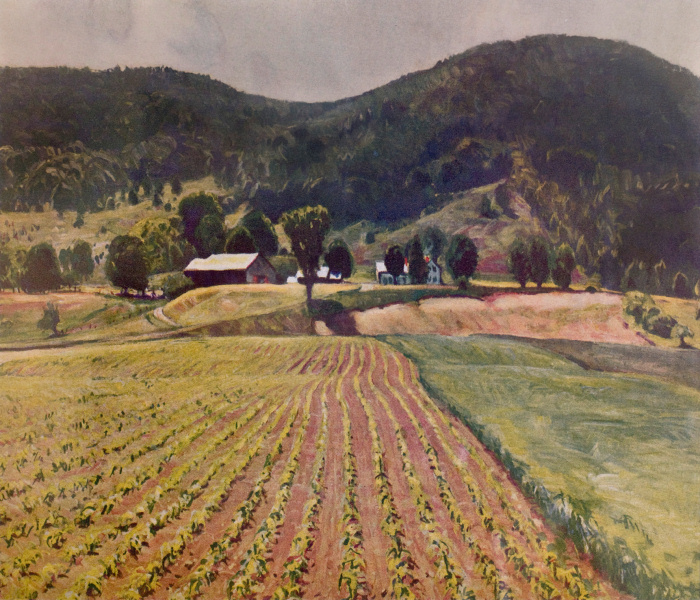June Corn
"Painted in 1933. Purinton Farm (now Leon Goodnow's) painted from back of old Strohecker House, (now Mr. Wise.) Largely exhibited as one of my outstanding canvases. Awarded 2nd Landscape Prize, at Albany Inst. of History and Fine Arts, 1937. Finally bought by Bartlett Arkell (owner of Beechnut Products) 15 West 10th Street New York City, for the Canajoharie N.Y. Museum. but I believe hung instead in his N. Y. business office."
Comments in diary by RSW
"...Robert Strong Woodward again shows the great understanding he has of the structure, one might almost call it the anatomy, of a landscape in his June Corn."
Boston Evening Transcript, Sept. 2, 1933
" .....Robert Strong Woodward deals with a difficult problem in his rows of June Corn, and produces an attractive, sunny composition."
Boston Herald, Oct. 1, 1933
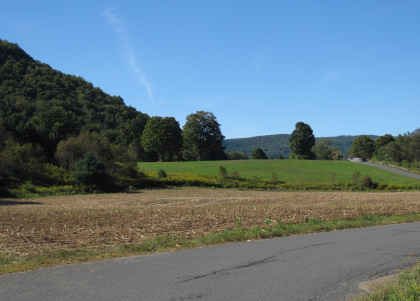
Farm land where June Corn was painted
In 1936 Robert Strong Woodward incidentally discovered an image of this painting on the cover of Farm Journal which greatly disturbed him. The following letter was fired off to the Grand Central Art Gallery: (Scroll down to read a printed text version of the letter.)
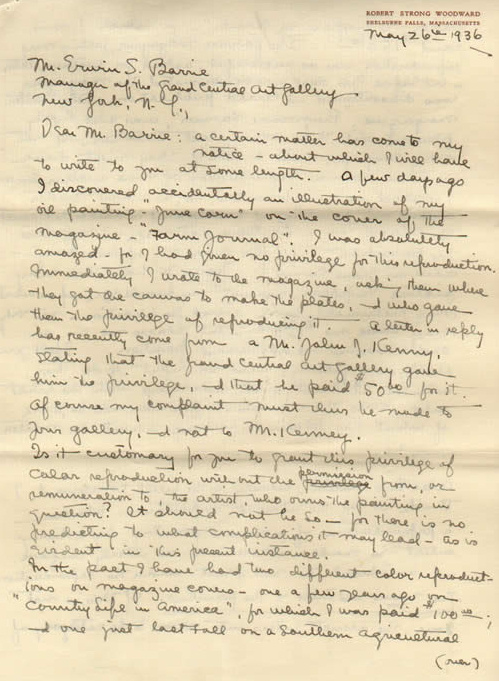
Page 1 of letter
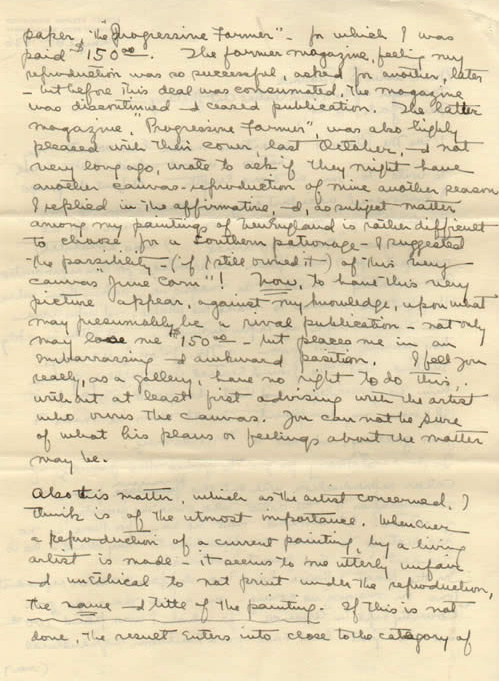
Page 2 of letter
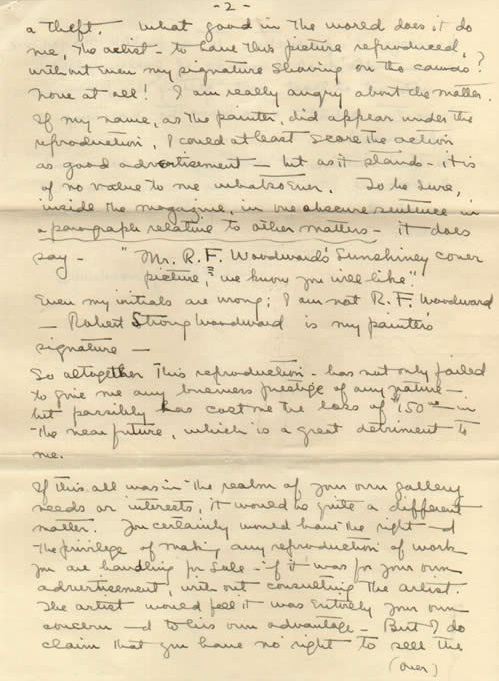
Page 3 of letter
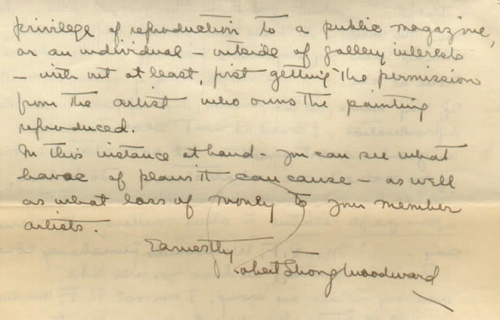
Page 4 of letter
Mr. Erwin S. Barrie
Manager of the Grand Central Art Gallery
New York, N.Y.
Dear Mr. Barrie:
A certain matter has come to my notice - about which I will have to write you at some length. A few days ago I discovered accidentally an illustration of my oil painting "June Corn" on the cover of the magazine "Farm Journal." I was absolutely amazed - for I had given no privilege for this reproduction. Immediately I wrote to the magazine, asking them where they got the canvas to make the plates, and who gave them the privilege of reproducing it. A letter and reply has recently come from a Mr. John J. Kenney, stating that the Grand Central Art Gallery gave him the privilege, and that he paid $50.00 for it. Of course, my complaint must thus be made to your gallery, and not to Mr. Kenney.
Is it customary for you to grant this privilege of color reproduction without the permission from, or remuneration to, the artist, who owns the painting in question? It should not be so - for there is no predicting to what complications it may lead - as is evident in this present instance.
In the past I have had two different color reproductions on magazine covers - one a few years ago on "Country Life In America," for which I was paid $100.00; and one just last fall on a Southern Agricultural the "Progressive Farmer" - for which I was paid $150.00. The former magazine, feeling my reproduction was so successful, asked for another, later - but before this deal was consumated, the magazine was discontinued and ceased publication. The latter magazine, "Progressive Farmer" was also highly pleased with their cover, last October, and not very long ago, wrote to ask if they might have another canvas reproduction of mine another season. I replied in the affirmative, and, as subject matter among my paintings of New England is rather difficult to choose for a southern patronage - I suggested the possibility (if I still owned it) of this very canvas "June Corn"! Now, to have this very picture appear, against my knowledge, upon what may presumably be a rival publication - not only may lose me $150.00 but places me in an embarrassing and awkward position. I feel you really, as a gallery, have no right to do this, without at least first advising with the artist who owns the canvas. You can not be sure of what his plans or feeling about the matter may be.
Also this matter, which as the artist concerned, I think is of the utmost importance. Whenever a reproduction of a current painting by a living artist is made - it seems to me utterly unfair and unethical to not print under the reproduction, the name and title of the painting. If this is not done, the result enters into close to the category of a theft. What good in the world does it do me, the artist - to have this picture reproduced even without my signature showing on the canvas? None at all! I am really angry about the matter. If my name, as the painter, did appear under the reproduction, I could at least score the action as good advertisement - but as it stands, it is of no value to me whatsoever. To be sure, inside the magazine, in one obscure sentence, in a paragraph relative to other matters - it does say - "Mr. R. F. Woodward's sunshiney cover picture, we know you will like." Even my initials are wrong: I am not R. F. Woodward. - Robert Strong Woodward is my painter's signature.
So altogether this reproduction, has not only failed to give me any business prestige of any nature - but possibly has cost me the loss of $150.00 in the near future, which is a great detriment to me.
If this all was in the realm of your own gallery needs or interests, it would be quite a different matter. You certainly would have the right and the privilege of making any reproduction of work you are handling for sale, if it was for your own advertisment, without consulting the artist. The artist would feel it was entirely your own concern and to his own advantage. But I do claim that you have no right to sell the privilege of reproduction to a public magazine, or an individual - outside of gallery interests - without at least first getting the permission from the artist who owns the painting reproduced.
In this instance at hand, you can see what havoc of plans it can cause - as well as what loss of money to your member artists.
Earnestly
Robert Strong Woodward.
Manager of the Grand Central Art Gallery
New York, N.Y.
Dear Mr. Barrie:
A certain matter has come to my notice - about which I will have to write you at some length. A few days ago I discovered accidentally an illustration of my oil painting "June Corn" on the cover of the magazine "Farm Journal." I was absolutely amazed - for I had given no privilege for this reproduction. Immediately I wrote to the magazine, asking them where they got the canvas to make the plates, and who gave them the privilege of reproducing it. A letter and reply has recently come from a Mr. John J. Kenney, stating that the Grand Central Art Gallery gave him the privilege, and that he paid $50.00 for it. Of course, my complaint must thus be made to your gallery, and not to Mr. Kenney.
Is it customary for you to grant this privilege of color reproduction without the permission from, or remuneration to, the artist, who owns the painting in question? It should not be so - for there is no predicting to what complications it may lead - as is evident in this present instance.
In the past I have had two different color reproductions on magazine covers - one a few years ago on "Country Life In America," for which I was paid $100.00; and one just last fall on a Southern Agricultural the "Progressive Farmer" - for which I was paid $150.00. The former magazine, feeling my reproduction was so successful, asked for another, later - but before this deal was consumated, the magazine was discontinued and ceased publication. The latter magazine, "Progressive Farmer" was also highly pleased with their cover, last October, and not very long ago, wrote to ask if they might have another canvas reproduction of mine another season. I replied in the affirmative, and, as subject matter among my paintings of New England is rather difficult to choose for a southern patronage - I suggested the possibility (if I still owned it) of this very canvas "June Corn"! Now, to have this very picture appear, against my knowledge, upon what may presumably be a rival publication - not only may lose me $150.00 but places me in an embarrassing and awkward position. I feel you really, as a gallery, have no right to do this, without at least first advising with the artist who owns the canvas. You can not be sure of what his plans or feeling about the matter may be.
Also this matter, which as the artist concerned, I think is of the utmost importance. Whenever a reproduction of a current painting by a living artist is made - it seems to me utterly unfair and unethical to not print under the reproduction, the name and title of the painting. If this is not done, the result enters into close to the category of a theft. What good in the world does it do me, the artist - to have this picture reproduced even without my signature showing on the canvas? None at all! I am really angry about the matter. If my name, as the painter, did appear under the reproduction, I could at least score the action as good advertisement - but as it stands, it is of no value to me whatsoever. To be sure, inside the magazine, in one obscure sentence, in a paragraph relative to other matters - it does say - "Mr. R. F. Woodward's sunshiney cover picture, we know you will like." Even my initials are wrong: I am not R. F. Woodward. - Robert Strong Woodward is my painter's signature.
So altogether this reproduction, has not only failed to give me any business prestige of any nature - but possibly has cost me the loss of $150.00 in the near future, which is a great detriment to me.
If this all was in the realm of your own gallery needs or interests, it would be quite a different matter. You certainly would have the right and the privilege of making any reproduction of work you are handling for sale, if it was for your own advertisment, without consulting the artist. The artist would feel it was entirely your own concern and to his own advantage. But I do claim that you have no right to sell the privilege of reproduction to a public magazine, or an individual - outside of gallery interests - without at least first getting the permission from the artist who owns the painting reproduced.
In this instance at hand, you can see what havoc of plans it can cause - as well as what loss of money to your member artists.
Earnestly
Robert Strong Woodward.
MLP
February 2011


